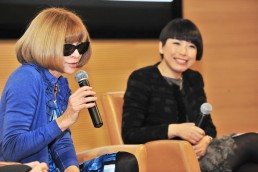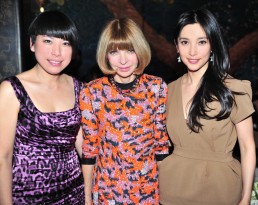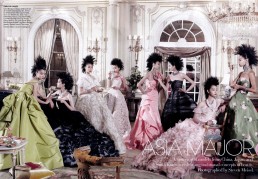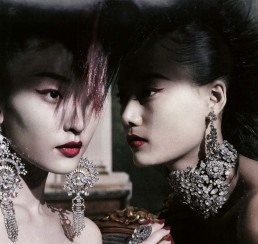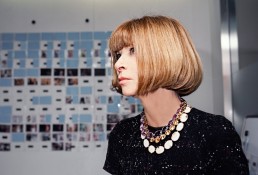On her first ever visit to China, Vogue's empress of high fashion says it's time for Asia to step out more confidently on the global catwalk. Controversy, however, dogs her latest issue.
ELFIN IN STATURE and instantly recognisable beneath pageboy bob haircut and Willy Wonka sunglasses, Anna Wintour strides towards the Central Academy of Fine Arts’ auditorium on a suitably frosty morning in the Chinese capital Beijing. Her reputation precedes her like a crackling and hostile storm front.
The British-born editor-in-chief of the American edition of Vogue is the most powerful and polarising figure in her industry. She has been slated as demanding, imperious and intimidating; labelled as ruthlessly ambitious and occasionally malicious. Wintour does not suffer fools at all, let alone gladly, according to one former assistant. And “she doesn’t do small talk”.
Inside the auditorium, a full house of Chinese design students has rallied to participate in a rare question-and-answer forum with high-fashion incarnate. They fidget skittishly while the press pack huddles in anticipation of an “Icy Wintour”, of a “Nuclear Wintour” (her distaste for that unflattering sobriquet is on the record). All await the headline scribbler’s mother lode.
NINETY MINUTES LATER and the dispersing congregation is nonplussed. Was Meryl Streep’s Cruella deVille-like fashion editor-cum-horror in The Devil Wears Prada really modelled on Wintour? (She attended the flick’s New York premiere wearing the label, by the way.)
Flanked on the Beijing stage by Vogue’s poised director of special events Sylvana Soto-Ward, its business-like fashion news director Mark Holgate and Vogue China’s effervescent editor-in-chief Angelica Cheung, composed Wintour has had the crowd eating from her expensively manicured hand. She has been gracious, charming and engaged.
“They were all so polite and well behaved,” Wintour says while settling in for our post-event tête-à-tête. “That’s quite unusual.”
The supposedly iron-fisted tastemaker disarmingly enquires where her interviewer comes from and how long he has lived in China. Couture’s uncontested uberfuhrer, it seems, is not at all averse to chummy chit-chat. It is her first visit to China and she appears impressed.
“I wouldn’t underestimate anything about this country right now,” says Wintour. Her impenetrable shades remain, as they will all morning (Wintour’s sunnies are fitted with corrective lenses, she has referred to them as her “armour”, and where else would she put them but on her face? She doesn’t care for handbags).
“I believe there is a fashion week in Beijing. Whether China will ever have a fashion week on the same scale as what we have in Paris or Milan or in New York, I couldn’t say, but growth here has already been so extraordinary. It’s fascinating. There is such an explosion going on. It’s fantastic. There is such appetite for fashion.”
IT IS SOON APPARENT that 61-year-old Wintour, with more than two decades at the helm of Vogue under her belt, is a polished operator and big-picture interviewee. She answers questions in broad but diplomatic strokes and parries when she deems it necessary.
Wintour has, after all, frequently been a lightning rod for tirades against her field, notably on issues such as fur (characteristic quote: “Fur is still a part of fashion, so Vogue will continue to report on it”), skinny models (she has come around: “We need to reverse the tyranny of sample clothes that just barely fit a 13-year-old on the edge of puberty”) and elitism (Wintour has been accused/credited with wiping out the early-1990s grunge look).
Asked for her perspective on up-and-coming Chinese designers, she says she does not have the experience to comment. The topic of Asian models, however, is perfectly timed for her and Vogue. “It’s incredible how that has changed in the last year or two years,” Wintour says. “You see so many more Asian models on runways these days.”
“Everybody seems to think they are a fashion editor, or a photographer, and everyone has an opinion and access to fashion in a way that they never had before. That makes our job particularly challenging”
Anna Wintour
Wintour enthusiastically flips through the latest, December issue to a lavish spread by veteran fashion photographer Steven Meisel, the snapper behind Madonna’s notorious 1992 book Sex.
Under the headline “ASIA MAJOR”, the Vogue shoot features eight models: China’s Du Juan, Liu Wen, Bonnie Chen and Lily Zhi, Koreans Hyoni Kang, So Young Kang and Lee Hyun, and Japan’s Tao Okamoto. Accompanying text describes how Asians have increasingly cat-walked into the limelight in recent years.
“We saw Liu Wen, with her sculptural, diamond-shaped cheekbones, at Lanvin, Oscar de la Renta, Michael Kors, and more,” it reads. “Tokyo-raised Tao Okamoto, she of the Beatles bowl cut, walked for Givenchy, Carolina Herrera, and Ralph Lauren (she has also appeared in the label’s ad campaign). The full-lipped, hypnotic-eyed Feifei Sun from Shandong, China, appeared in 39 shows in her second season.
“And these women are not just selling high fashion. Poised, porcelain doll–faced Du Juan (she trained as a ballerina in Shanghai) and Shu-Pei Qin, her brows like accent marks, loom large on Gap billboards; Estée Lauder recently took on Wen as a new face, the first ethnic model since Liya Kebede, in 2003, to represent the classically American beauty powerhouse; and Qin, from Henan, China, has signed a contract with Maybelline.”
Wintour continues: “Grace Coddington, my creative director, and I were discussing it when we came back from the collections last season. We were particularly impressed by Oscar do la Renta’s collection and we wanted to do something special.
“Grace said, ‘You know what, I think we should shoot a whole story with Asian girls.’ Five years ago this would not have been possible. They are all extraordinary and beautiful.”
THE SHOOT, PRESENTING the East’s finest decked out in evening gowns and sporting gravity defying faux-mohawk hairdos, has been criticised, however. At the Huffington Post, contributors going by the name “Disgrasian” — self-described as “two Asian American chicks who grew up in the heartland” — took umbrage at Vogue’s assertion that Asian models are “redefining traditional concepts of beauty”.
Disgrasian wrote: “There are plenty of places in the world where, traditionally speaking, Asian women have long been considered beautiful. Like in, um, Asia, for example?”
Such grumblings have since been mulled over in new media worldwide, including on blogs from Britain’s Daily Telegraph newspaper, the Financial Times and New York magazine.
Later, Vogue China’s Beijing-born Cheung will bristle at such comments and spring to Wintour’s defence. “At Vogue China, we have been making huge efforts to promote Chinese models overseas and it is great to see such real support from my American colleagues,” Cheung says.
“They actually do something about it instead of just talking. I find the criticisms irrelevant because it is so easy to criticise others who make an effort. I would say to any detractors, ‘Show us what you have done to support Asian models.’”
DURING THE BEIJING forum, Wintour hinted at aloof indifference to such unsolicited opinions when asked how Vogue sustains its influence and clout (the US edition sells over 1.2 million copies a month; a 2007 issue of the magazine, the creation of which was chronicled in documentary The September Issue, reportedly reached a staggering 13 million readers; copies can be snapped up on eBay for around US$100).
“It’s a particularly interesting time right now,” Wintour said. “Everybody seems to think they are a fashion editor, or a photographer, and everyone has an opinion and access to fashion in a way that they never had before. That makes our job particularly challenging and even more useful, because there is an awful lot of noise out there; everyone thinks they are an expert.”
She went on to state that Tom Ford “so hates” the internet’s influence on fashion that he invited only 100 guests to his September show in New York. Reporters from daily newspapers were excluded.
“None of us were allowed to photograph the collection — although we managed to sneak around that with Grace’s wonderful drawings,” Wintour recalled. “But [Ford] gave Vogue magazine an exclusive for that particular collection because he is trying to bring back into the industry some sense of fashion being special again, and I think Tom has a very valid point. Sometimes women feel that clothes are overexposed by the amount of [coverage] they get online.”
WHILE HER VISIT to Beijing will prove to be part pleasure (with sightseeing on the Great Wall, in the Forbidden City and at the galleries of the 798 Art District) and part fact-finding mission, Wintour sees her role at Vogue as semi-ambassadorial for the US fashion industry. She says American brands have been relatively dawdling in entering the China market compared to their European counterparts.
“Dolce & Gabbana … I know they were just here [in China, in Shanghai],” she says. “They loved it. They just adored it. They came straight to New York afterwards and they were full of stories.
“The American design community cannot afford to ignore the strength of this market, and my understanding is that there are a lot of [retail] properties being looked at right now by key American designers. And I certainly plan to go back to the US and encourage them to come here.
“It’s going to be a huge market for them. There’s a limit to the amount of growth possible in the US, so we all have to look at the emerging countries for expansion.”
Wintour has previously expressed the opinion that politics and fashion do not make comfortable bedfellows. In a 2006 interview in Britain’s Guardian newspaper she opined, “Washington is frightened of fashion. I think the British government is the same … People in political office tend to get extremely nervous about fashion because they feel it’s frivolous. And they don’t want to look too elitist or too silly or whatever it may be.”
Recalling that statement in Beijing, Wintour grins. “Well, actually, I think, thanks to the first lady in the US, that has all changed,” she says. “[Michelle Obama] really has been a standard bearer for fashion. She obviously enjoys it, and she wears it so well. She has been so incredibly supportive of young American talent, of designers like Jason Woo, Derek Lam, Narciso [Rodríguez], Michael Kors, and by being so careful of the designers she wears when she goes abroad, so I think that’s really helped shift opinion.
“And I’m very impressed by Mrs Cameron, and I think that she has already announced that she’s going to take a leadership role in supporting British fashion. So, I think, with Mrs Cameron and Mrs Obama in place, we have a lot to be grateful for.”
And of the fashion she has witnessed on Beijing’s nippy winter streets? “I notice a lot of really interesting hair, I have to say. The colours and cuts are fantastic.”
Wintour suddenly becomes the most animated she has been all morning, and for a brief moment, perhaps, reveals an endearing glimpse of the shy teenager who, in the swinging London of the 1960s, rebelled against her school dress code by taking up the hemlines of her skirts.
“It seems to me that, among young people, there has been an explosion in self-expression here. It’s great,” she says.
“And I see a lot of hats. The Chinese seem big on hats.” ◉
Highlights from Anna Wintour’s Q&A session with students from Beijing’s Central Academy of Fine Arts
On visiting the Beijing offices of Vogue China
“It reminded me of when I started out in London. I was working for Harper’s & Queen at the time. We had a tiny staff and basically you had to do everything: take pictures, write captions, cover the market, do the layouts, follow up … To me, that was the best training.
When I came to the US and American Vogue, I discovered we had a shoe editor, and a lady in her 90s who was the fabrics editor. There was an underwear editor … there were so many layers, and I think that’s not always helpful to understanding the industry.”
On The Devil Wears Prada and The September Issue
“I enjoyed the movies. I thought that they were highly entertaining and they were extremely kind to me because, of course, actually I beat all my assistants, I lock them up in cupboards and none of them get paid.”
On nurturing emerging talent
“When I first met John [Galliano] he did not have enough money to take a taxi. I would lend him money for fares; he would sleep in my hotel room. I used to fly him over from London to New York because I felt it so important for him to meet the right people. I helped him find investors. We really went to everybody and everywhere to support John because we realised he was a unique talent, and it’s Vogue’s responsibility to nurture and support talent as much as we possibly can.”
On the Chinese fashion industry
“From an American point of view, China is becoming an incredibly important market. Everywhere you go there is this great drum roll that started five years ago, asking, ‘What do you think about China?’ We decided it was time to make our own visit and to form our own opinions. I think American brands are a little bit behind in coming to China and I want to encourage them all to visit, to come and open stores here. We are behind the Europeans in that regard.”
On setting out on a career in fashion
“Fashion does not exist in a vacuum. Fashion reflects culture; it reflects our times. A great fashion photograph can tell you just as much about what is going on in our world as any headline or TV report, so go out, go to the galleries, go to the theatre, read books, travel … All of that will come back to reward you later.
“I was so lucky as a young girl growing up in London. I travelled as much as possible. That kind of exposure takes you through life in a different way. Particularly today, when everything is so incredibly global. It’s important to get out there to see for yourself. You really can’t learn only by looking at a computer screen.”
On assessing a designer’s work
“Well, I’m not always right, that’s for sure. The most important thing is to be honest. Designers have friends, the press and whoever rushing backstage to tell them they are wonderful. That may be very nice to hear but it’s not always constructive for someone trying to develop a business.
“Vogue always tries to be helpful and to tell the truth. It’s equally non-constructive to completely knock somebody. We gently try to explain our point of view and what we think they might try and change, or what a collection might be lacking. Then they usually go ahead and do whatever they want to do anyway.”
On her professional life with Vogue
“I feel I’m the luckiest person in the world. I have the best staff in the world. I’ve been doing the job for 100 years and I still can’t wait to get to the office every morning. The wonderful thing about fashion is that it changes all the time and, if you are working for a magazine like Vogue, you have the opportunity to work with the most incredible talent.” ◉
Wintour made her first visit to China in November 2010. Versions of this interview then ran in Hong Kong's South China Morning Post (download PDF) and Abu Dhabi's The National (PDF).
SHARE


